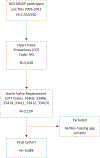A Comparison of Three Frailty Indices in Predicting Morbidity and Mortality After On-Pump Aortic Valve Replacement
- PMID: 28857797
- PMCID: PMC6457243
- DOI: 10.1213/ANE.0000000000002411
A Comparison of Three Frailty Indices in Predicting Morbidity and Mortality After On-Pump Aortic Valve Replacement
Abstract
Background: Aortic valve replacement is a high-risk surgery (3%-5%, 30-day mortality) performed on approximately 30,000 elderly patients a year in the United States. Currently, preoperative risk assessment is based on a composite of medical examination and a subjective evaluation for frailty ("eyeball test"). Objective frailty assessment using validated indices has the potential to improve risk stratification. The purpose of this study was to (1) establish whether frailty can predict 30-day mortality and composite morbidity in patients undergoing aortic valve replacement and (2) compare the predictive ability of 3 frailty indices in this population.
Methods: This study was a retrospective cohort study of 3088 patients 65 years old and older undergoing aortic valve replacement surgery (based on current procedure terminology codes) between the years 2006 and 2012 extracted from the American College of Surgeons National Surgical Quality Improvement Program database. Frailty was assessed using the modified frailty index, risk analysis index, and Ganapathi indices. Outcomes measured were 30-day mortality and composite morbidity (myocardial infarction, cardiac arrest, pulmonary embolism, pneumonia, reintubation, renal insufficiency, coma >24 hours, urinary tract infections, sepsis, deep vein thrombosis, deep wound surgical site infection, superficial site infection, and reoperation).
Results: Frailty was a better predictor of mortality than morbidity, and it was not markedly different among any of the 3 indices. Frailty was associated with an increased risk of 30-day mortality and longer lengths of stay.
Conclusions: Frailty can predict mortality in patients undergoing aortic valve replacement. Choice of frailty index does not make a difference in this patient population.
Conflict of interest statement
The authors declare no conflicts of interest.
Figures


References
-
- Rodés-Cabau J, Mok M. Working toward a frailty index in transcatheter aortic valve replacement: a major move away from the ‘eyeball test.’ JACC Cardiovasc Interv. 2012;5:982–983. - PubMed
-
- Campbell AJ, Buchner DM. Unstable disability and the fluctuations of frailty. Age Ageing. 1997;26:315–318. - PubMed
-
- Sepehri A, Beggs T, Hassan A, et al. The impact of frailty on outcomes after cardiac surgery: a systematic review. J Thorac Cardiovasc Surg. 2014;148:3110–3117. - PubMed
-
- Sündermann SH, Dademasch A, Seifert B, et al. Frailty is a pre-dictor of short- and mid-term mortality after elective cardiac surgery independently of age. Interact Cardiovasc Thorac Surg. 2014;18(5):580–5. - PubMed
Publication types
MeSH terms
Grants and funding
LinkOut - more resources
Full Text Sources
Other Literature Sources
Medical

